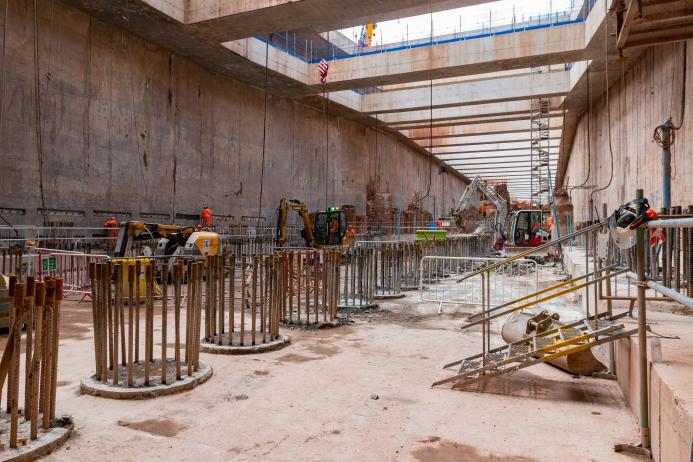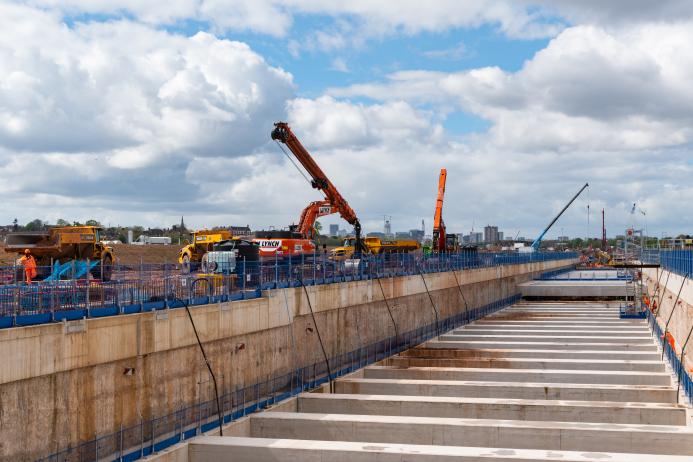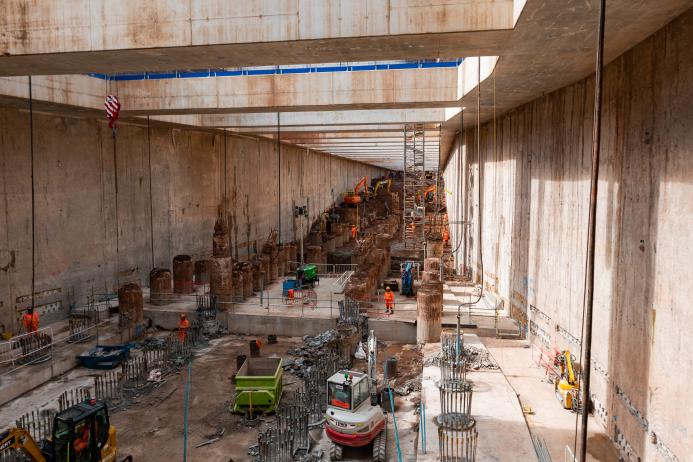HS2 completes Bromford Tunnel portal at Washwood Heath
Work to build the 5.6km Bromford Tunnel bringing high-speed trains into Birmingham has taken a leap forward as excavation of the 22 metre deep west portal is completed.
The portal at Washwood Heath has been finished in readiness for the two 1,600 tonne tunnel boring machines (TBMs) building the twin-bore tunnel to complete their journeys from Water Orton in North Warwickshire.
The huge earthworks operation has taken a team of 130 people from HS2’s construction partner Balfour Beatty VINCI (BBV) nine months to complete.
Groundwork specialists from Coventry-based Duo Group supported BBV with the complex excavation programme to extract 53,400m3 of earth from the ground. The spoil has been transported on specially built haul roads to support construction of the Delta Junction – a triangular section of 13 viaducts in North Warwickshire.
The Washwood Heath portal is the deepest of four tunnel portals on the Midlands section of the HS2 route. A two-year programme of ground reinforcement works, delivered by the Bachy Soletanche and Balfour Beatty Ground Engineering joint venture (known as SB3), began in November 2021 to prepare for the portal’s excavation.
The portal is at the start of a 750m-long cut and cover structure, which is currently being excavated and built by SB3. This is where HS2 trains will emerge from the tunnel and travel below ground level, before raising up onto a series of viaducts into Birmingham’s Curzon Street Station.

‘Mary Ann’, the first TBM to launch from Water Orton in 2023, is expected to break through the portal wall at Washwood Heath by the end of 2024, with the second TBM ‘Elizabeth’ set to finish her drive by Autumn 2025.
At 65 hectares – the equivalent of 100 football pitches - Washwood Heath is one of HS2’s largest construction sites. Next to the tunnel portal, HS2’s Depot and Network Integrated Control Centre will also be built – acting the nerve centre of the high-speed rail network. From this site, trains will be serviced and stored and the real time operation of the railway will be controlled.
The site has also spurred the development of a 24 hectare brownfield site which will unlock land for commercial use and logistics space, creating opportunities for employers and the community, and more than 1,000 new jobs for local people.
Commenting on the progress, Alvin Pedzai, HS2 project manager responsible for main works civils delivery at Washwood Heath said: “With two tunnel boring machines in the ground and excavation of the Birmingham tunnel portal complete, the complex feat of engineering required to bring HS2 trains into central Birmingham is well and truly underway.
“Local businesses have played a huge role in this two-year programme of work, which has been taking shape alongside our plans to build the new network control centre and maintenance depot - the beating heart of HS2’s operation here in Washwood Heath.”
Tim Cook, project manager at Balfour Beatty VINCI said: “The Bromford Tunnel portal at Washwood Heath will act as the gateway that will take HS2 trains in and out of Birmingham city centre. At a depth of 22 metres, completing this huge excavation operation is a significant moment for the project, and for the region.

“The team is now focussed on the next challenge on this vast site - a 750m-long cut and cover structure next to the portal, where HS2 trains will emerge from the tunnel and travel below ground level, before heading into Birmingham.”
On the wider 65 hectare site, over one million cubic metres of earth has been excavated, with the recycled material cleaned and reused to level the ground, paving the way for detailed design and construction of the new maintenance depot and control centre to start next year.
By recycling and reusing material on the site, BBV have eliminated the need to import aggregate, a strategy which has avoided over 50,000 lorry movements on local roads, minimising the impact of HS2’s work on nearby communities.
BBV have also diverted Wash Brook, which ran north to south through the site. The brook, which connects to the River Tame, is just one of the environmental design features planned for the site to provide local wildlife habitats and enhance its aesthetic appeal.

